Surfing in Hawaii: Discovering Oahu's Waves
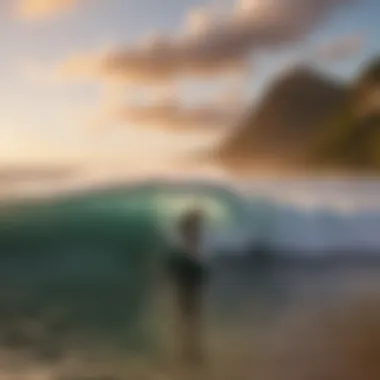
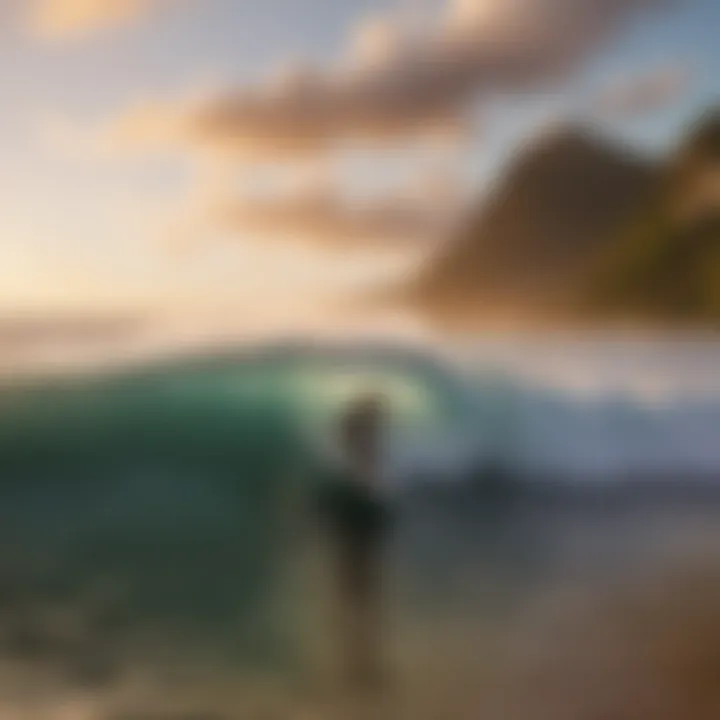
Intro
Surfing in Oahu is not just a sport; it's an experience that weaves itself into the very fabric of Hawaiian culture. As the sun rises over the sapphire waves, surfers from all walks of life converge on this Pacific paradise to ride the notorious swells that have echoed through legends and lore. For many, Oahu's beaches like Waikiki and the North Shore stand as sacred grounds, where every crest of the wave brings forth a rush of excitement and connection to nature.
In this article, we will look closely at the techniques and skills required for both beginners and experienced riders and also delve into the vital aspects of safety and gear necessary for a successful day out on the water. With the right preparation and understanding, surfers can enhance their enjoyment and competence within Oahu's diverse surf landscapes.
The allure of this island stems not only from its breathtaking beaches but also from its deep-rooted traditions surrounding the sport. Surfing in Oahu has a history that runs as deep as the ocean itself, bringing with it stories of ancient Hawaiian warriors who harnessed the waves for transport, competition, and solace. Each surf spot on the island offers a different feel—some challenging, others accommodating, catering to different skill levels and preferences.
Before we plunge into the specifics, let’s outline the critical components of this guide. We'll pinpoint the essential techniques and skills needed to ride the waves confidently, discuss safety protocols to keep every adventurer out of harm's way, and provide gear recommendations tailored for both novices and pros. This thorough examination ensures that readers are not only ready to catch waves but also prepared to dive head first into the vibrant surfing culture that thrives on the shores of Oahu.
Intro to Oahu's Surfing Culture
Surfing in Oahu is more than just a sport; it embodies a culture, a way of life deeply rooted in the Hawaiian islands. From the moment the ancient Polynesians first rode the waves, this art form has evolved, reflecting both tradition and modernity. Understanding this rich history and its cultural significance is crucial for anyone looking to immerse themselves in the surfing experience on this iconic island.
This section delves into the historical context of surfing, showcasing not only its origins but also how it transformed into a global phenomenon. We'll explore the current surfing landscape, which is a fine blend of traditional values and cutting-edge innovations. Oahu's beaches are not just places for recreation but are sacred grounds to many locals. The essence of surfing here means respecting the ocean, cherishing the land, and honoring the ancestors.
Historical Context
The Origins of Surfing in Hawaii
Surfing traces its roots back to ancient Hawaii, where it was known as "He'e Nalu." This activity was a reflection of the Hawaiian spirit and identity, providing a sense of community among those who surfed the waves. It was not merely a pastime but a sport that held social and spiritual significance.
One unique characteristic of this origin story is the way surfing was intertwined with Hawaiian social hierarchy. Chiefs and nobility were often seen riding on wooden boards made from the best materials, while commoners used lighter, simpler boards. This speaks volumes about the importance placed on surfing in Hawaiian society and its role in establishing social order.
This historical context contributes significantly to the overall narrative of Oahu's surfing culture, grounding it in rich traditions that continue to resonate with today’s surfers.
Evolution of Surfing Techniques
Over the years, surfing techniques have undergone substantial changes. From the traditional wooden surfboards to modern polyurethane and epoxy designs, the materials and methods have been refined to enhance performance. Surfers have adapted to new styles, including shortboard and longboard riding, each with its own unique quirks and flair.
What stands out in this evolution is the continuous blend of old and new. While some surfers swear by the original longboards, others prefer the fast-paced styles of shortboarding. Despite these variations, they all pay homage to the roots of surfing, which is key for anyone looking to appreciate the local culture.
This diverse range of techniques provides added depth to the understanding of Oahu's surfing scene and invites both beginners and seasoned surfers to explore multiple styles.
Cultural Significance of Surfing
Surfing represents more than just the thrill of catching a wave; it is a cultural cornerstone for the Hawaiian people. The act itself is often accompanied by rituals to show respect to the ocean and its environment. Narratives of demigods, such as Kanaloa and Makahiki, are woven into modern surfing, blending spirituality with physical activity.
The grass roots of surfing in Hawaii contribute to a vibrant community that holds workshops, competitions, and events aimed at preserving this legacy. The annual Duke’s OceanFest is one such event that celebrates both the sport and the history behind it.
For tourists and locals alike, understanding this cultural significance facilitates a more meaningful connection with the ocean and its inhabitants. Learning about the stories and legends that tie surfers to the land and their ancestors greatly enriches the surfing experience.
Modern Surfing Scene
Between Tradition and Innovation
The surfing scene in Oahu today is a fascinating intersection of tradition and innovation. Surfers on the North Shore may still be found using classic longboards while simultaneously pushing the limits of new technology with high-performance boards. The local surf schools often teach traditional techniques alongside modern methods, ensuring that both aspects are preserved.
This duality presents a comprehensive view of surfing culture, allowing individuals to engage with both its historic roots and futuristic innovations. Those looking to partake can find themselves motivated by the stories of legendary surfers while riding on the latest gear.
Global Influence of Hawaiian Surfing
Hawaiian surfing has influenced countless surfing subcultures worldwide, from the sandy beaches of California to the coastlines of Australia. The past decades have seen an influx of international surfers flocking to Oahu, hoping to carve their names into this historic surf scene.
This global interplay not only enriches Oahu’s surfing community but also cultivates an ongoing exchange of knowledge and technique, pushing the envelope on what surfing can be.
Surf Competitions and Events
Competitions like the Vans Triple Crown of Surfing attract top talents from around the globe, showcasing the prowess of elite surfers. Participating in these events offers a glimpse into the high-stakes world of professional surfing, where tradition meets modern sport.
These events draw considerable crowds and contribute to Oahu's local economy while sustaining its rich surfing heritage. Every wave ridden during these competitions tells a story, intertwining personal goals with the broader narrative of Hawaii’s surfing culture.
Geography of Oahu's Surf Spots
Understanding the geography of Oahu's surf spots is crucial for anyone looking to catch a wave on this iconic island. Oahu's diverse coastline not only creates many opportunities for surf breaks, but the geographical features also dictate the quality and type of waves that can be found at each location. Knowing where to go based on skill level and wave conditions can significantly enhance the surfing experience, making it enjoyable and safe.
North Shore
Renowned Beaches: Pipeline and Sunset Beach
The North Shore is arguably the crown jewel of Oahu’s surfing scene. Pipeline, in particular, stands out because its waves create impressive tubes that attract surfers from around the world. The key characteristic of Pipeline is its dangerously beautiful barreling waves, which are best suited for seasoned surfers. Surfers flock here not just for the thrill but also to witness the breathtaking displays of skill and courage.
Sunset Beach, adjacent to Pipeline, offers a different yet equally compelling experience. The waves here tend to be a bit more forgiving, which draws both intermediate and advanced surfers looking to challenge themselves. What makes these spots a beneficial choice are the consistent winter swells that produce waves of varying heights and intensity.
While Pipeline’s powerful breaks can yield some exhilarating rides, they can also be treacherous. Surfers have to be mindful of the unique feature of the reef below, which can cause injuries when waves throw surfers off balance. On the plus side, this sharpness also generates mighty waves that are part of Pipeline's allure.
Seasonal Conditions and Wave Patterns
The seasonal conditions on the North Shore dramatically influence wave patterns. Winter months bring substantial swells, complemented by the north winds, creating larger surf compared to the summer season when swells diminish.
Understanding this dynamic is vital for any surfer hoping to navigate Oahu's waters effectively. A major unique feature here is the predictability of these patterns, which can be charted and thus used to plan surf days.
Surfers can take advantage of this predictability, adapting their surfing strategies to the season. The trade-off, however, includes the sheer number of surfers that arrive during peak season, which can lead to crowded waters at popular spots like Pipeline.
South Shore
Waikiki: A Tourist Hotspot
Waikiki surf breaks symbolize Oahu’s embrace of tourism and the surf lifestyle. This beach is renowned not just for its gentle waves, but for the historical significance it holds as the birthplace of modern surfing. The waves here are mostly manageable and create an ideal environment for beginners. The key characteristic of Waikiki is its expansive sandy beach and consistent, mellow surf, making it a popular choice for many first-time surfers.
Moreover, the town is dotted with surf schools, providing instruction for those new to the sport. Waikiki’s setting is breathtaking, with Diamond Head providing a stunning backdrop for surfing.
However, this beautiful scene comes with its downsides—heavy foot traffic and overcrowding can sometimes make for a less-than-ideal surfing experience, especially during peak tourist seasons.
Factors Influencing Wave Quality
The factors influencing wave quality at Waikiki include tide conditions and wind direction. Tides can either enhance or diminish wave performance, while the prevailing trade winds can create choppy waters that are less favorable for surfers.
These elements are critical for a successful surf outing. Understanding how local weather changes can affect the water is invaluable for any surfer. The unique feature of being able to surf comfortably in various tides makes Waikiki appealing, yet surfers still need to strive for awareness, as the weather can shift rapidly, impacting wave consistency.
East and West Shores
Hidden Gems Along the Coast
The east and west shores of Oahu host a myriad of hidden gems waiting to be discovered. While places like Waimea Bay and Makaha may grab the headlines, there are lesser-known surf spots that provide a more intimate experience away from the crowds.
Such locations often feature pristine waters and undisturbed waves, perfect for those looking to escape the hustle of popular beaches. Surfers appreciate these hidden gems because they offer waves that can vary greatly in quality and character, often giving skilled surfers a chance to forge their own path.
The key characteristic of these spots is their unpredictability; they can be fickle and often depend heavily on local swell conditions, making them a double-edged sword. If successful, the experience can be unparalleled. If the conditions are less favorable, however, surfers might find themselves facing choppy or flat waters.


Less Crowded Adventures
For those weary of battling crowds, exploring the less crowded adventures along the coast can provide the peace often missing from more popular surf spots. The west side, particularly, offers secluded beaches where surfers can connect more deeply with nature and surf without interruption.
This aspect greatly appeals to individuals who are either looking to refine their skills or simply enjoy the tranquility of the ocean. One of the unique features here is the opportunity to commune with local marine life, as less populated areas tend to be rich in wildlife.
On the downside, these quieter spots may lack the amenities found at tourist-heavy beaches and could present their own challenges regarding wave quality and safety—an essential consideration for surfers venturing off the beaten path.
There's something special about finding your own wave, enjoying nature's rhythm without the distractions of a bustling surf scene.
By understanding the geography of Oahu's surf spots, surfers can maximize their experiences, whether they seek thrilling challenges, serene environments, or the vibrancy of community surf culture.
Understanding the Ocean: Wave Dynamics
The ocean may seem like a vast, undulating body of water from afar, but for surfers, it’s a complex playground governed by specific rules and dynamics. Understanding how waves form, break, and behave is essential for anyone who wishes to navigate Oahu's diverse surf spots. Wave dynamics influence everything from the type of surfboard an individual might use to how they choose to approach a session at the beach.
Grasping these concepts allows surfers to make informed decisions, improve their skills, and enhance their safety while riding the waves. This section dives deep into the intricacies of wave types, their behaviors, and seasonal variations that dictate surfing conditions.
Types of Waves
Peaky Waves vs. Rolling Waves
Peaky waves are characterized by their steep, pointy tops that rise abruptly, often creating the ideal conditions for high-energy rides. When a swell hits a shallow reef or ledge, it can form a well-defined peak that offers an exhilarating take-off point for surfers. The nature of these waves tends to attract more experienced surfers who relish the challenge of balancing on the powerful face.
On the flip side, rolling waves provide a more gradual, smoother ride. These are often the waves that form in deeper water and are less steep. Rolling waves are popular among beginners, as they offer more time to react and maneuver. However, riding these waves might lack the thrill of faster waves, making peaky waves a favored choice among thrill-seekers. Each has its unique charm and caters to different skill levels and preferences.
Understanding Break Patterns
Understanding break patterns is crucial for surfers looking to optimize their time in the water. The break is where waves begin to lose their energy and crumble. There are three main types of breaks: point breaks, beach breaks, and reef breaks. Each of them offers distinct characteristics that can affect how surfers approach riding.
Point breaks occur when waves refract around a point of land creating longer rides. Beach breaks aren't as predictable; they can shift with the sand and produce inconsistent waves. Reef breaks, common in places like Oahu, tend to provide powerful, hollow waves that require advanced skills but reward surfers with some of the most memorable rides.
Seasonal Variations
Winter Swells and Summer Lulls
Seasonal swells are a critical factor influencing wave size and quality at Oahu's surf spots. During winter, the North Shore is blessed with powerful swells that can reach impressive heights, attracting not just local surfers but also those from all corners of the globe. These winter swells can create perfect conditions for competitions and seasoned surfers to showcase their skills.
Contrastingly, summer typically brings smaller, more manageable waves known as summer lulls. While not as thrilling, these conditions are ideal for novices wanting to hone their skills without the intimidation of massive surf. Both seasonal conditions offer unique opportunities and challenges for surfers focusing on improving their technique.
Impact of Local Weather Conditions
Local weather conditions play a critical role in determining surf quality and safety. Factors like wind speed, direction, and rainfall can influence how waves break and the overall surfing experience. For instance, offshore winds often create cleaner, more organized waves, while onshore winds can lead to choppy, unpredictable surf.
Also, rain can cause river runoff, affecting the water quality and surf conditions, making it less inviting. Surfers must keep a close eye on weather forecasts to ensure they are surfing during the best conditions. Not only does this knowledge enhance the session’s enjoyment, but it also ensures surfers can practice safely.
"Understanding wave dynamics is not just about catching waves; it’s about respecting the ocean and enhancing your experience."
In summary, comprehending wave dynamics gives surfers a solid foundation that empowers them to enjoy the sport's depths while minimizing risks. Whether you’re catching a peaky wave or learning the subtleties of seasonal shifts, this knowledge is vital for becoming a proficient surfer, especially in a legendary surf destination.
Essential Surfing Skills
Understanding essential surfing skills is crucial for anyone looking to enjoy the waves of Oahu. These skills not only enhance your performance but also increase safety and boost your confidence in the water. Knowing how to paddle effectively, position yourself right, and ride waves is fundamental. Surfing is as much about being in tune with the ocean as it is about technique.
Paddling Techniques
Effective Stroke Mechanics
Paddling is the core of getting into the surf. Having the right stroke mechanics can set the stage for a successful ride. Good paddling technique involves a combination of arm strength and body positioning. You want to engage your core while maintaining a flat, streamlined body on the board. This reduces drag, making it easier to cut through the water.
The main characteristic of effective stroke mechanics is the reach and pull. You reach forward with one arm while the other is in the water, pulling down and back. Many surfers swear by this technique because it allows for greater efficiency and quicker entry into the wave. What sets this approach apart is its low-impact nature. It conserves energy, which is vital for longer surf sessions. However, if done improperly, it can lead to fatigue and wasted effort.
Building Endurance
Endurance is another critical aspect of paddling. It allows surfers to maintain their energy throughout prolonged sessions. Having the stamina to paddle out past the break is an essential skill for any surfer, especially in Oahu's challenging waters.
Building endurance can involve cardio exercises like swimming or running. The key characteristic here is that these exercises directly contribute to how long you can surf without feeling worn out. The unique feature of this is that it not only benefits surfing but overall fitness as well. However, if you focus only on endurance without strength training, you might find yourself lacking the power to paddle effectively when you need it.
Positioning and Timing
Choosing the Right Wave
Understanding how to choose the right wave can make or break your surfing experience. Not every wave is created equal, and recognizing which ones are worth your effort saves time and keeps frustration at bay. The key characteristic of selecting a wave is knowing the conditions—how the waves are breaking and whether they fit your skill level. Choosing wisely means more successful rides and an overall better experience.
The unique feature of this skill is its adaptability. Beginners may lean towards smaller, softer waves, while more experienced surfers might go for larger, powerful breaks. A disadvantage, however, can be underestimating wave power, which can lead to wipeouts.
Reading Ocean Swells
Reading ocean swells is an advanced skill integral to improving your surfing. It offers insight into how waves will behave before they reach the shore. Observing patterns in ocean swells provides crucial information when you're out on the water.
The key characteristic of reading the swells is understanding their periodicity and size. This ability allows surfers to anticipate the right moment to paddle for a wave and position themselves correctly. A unique advantage here is developing a sixth sense about wave behavior, which is both exhilarating and improves overall performance. One downside might be that it requires practice and time to master.
Riding the Wave
Techniques for Balance
Balance is the essence of riding the wave. Different styles exist, but the underlying goal remains the same: staying upright while maneuvering on the board. The core of balance techniques is body positioning. Keeping your weight centered over the board helps maintain control, allowing for fluid adjustments.
This skill is essential in surfing as it directly impacts performance. A unique feature of balance techniques is the deliberate practice on flat ground before hitting the waves. This allows surfers to practice foot placement and weight shifts without the unpredictable nature of water. However, concentrating too much on balance may lead to overthinking, which can disrupt the natural flow of riding the wave.
Variety of Turns and Maneuvers
Exploring different turns and maneuvers expands a surfer's repertoire. This skill allows for creative expression on the waves and can impress onlookers and peers. Whether it's a cutback, a snap, or a floater, each maneuver requires distinct weight distribution and timing.
The key characteristic of these techniques is adaptability. Surfers can choose different maneuvers based on wave conditions and their personal style. This not only leads to more enjoyable rides but also contributes to personal growth in the sport. However, the downside is the potential for injury if techniques are executed incorrectly, particularly in more advanced maneuvers.
"Surfing is a blend of art, science, and culture—knowing the skills is just the beginning."
In summary, mastering these essential surfing skills boosts confidence and enjoyment while navigating the ocean. The combination of effective paddling, strategic positioning, and precise riding techniques creates a solid foundation for a rewarding surfing experience in Oahu.
Safety Considerations
When it comes to surfing in Oahu, safety can never be overstated. This section dives into understanding the essentials of safety out on the waves, which ultimately enriches the surfing experience. Recognizing and navigating through hazards, both on land and in water, contribute significantly to enjoying this beloved sport. Equip yourself with the right knowledge, and you can prevent accidents that could ruin the thrill of riding those world-class waves.
Understanding Surf Etiquette
Respecting the surfing community through etiquette is crucial for a smooth experience in the water. Knowing the rules can prevent misunderstandings and promote harmony among surfers of all skill levels.
Right of Way Principles
The right of way is paramount in surfing, governing who gets to ride a wave and in what order. In essence, the surfer closest to the peak of the wave holds the right of way. This principle leads to smoother take-offs and fewer collisions, creating a safer environment for everyone involved. By following this guideline, surfers not only show respect to their fellow riders but also reduce potential conflicts.
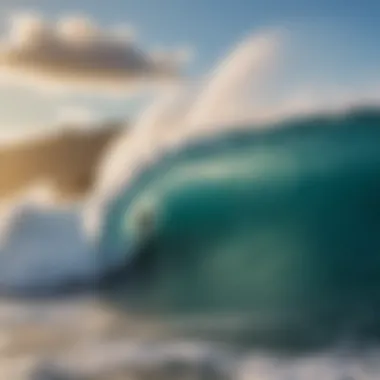
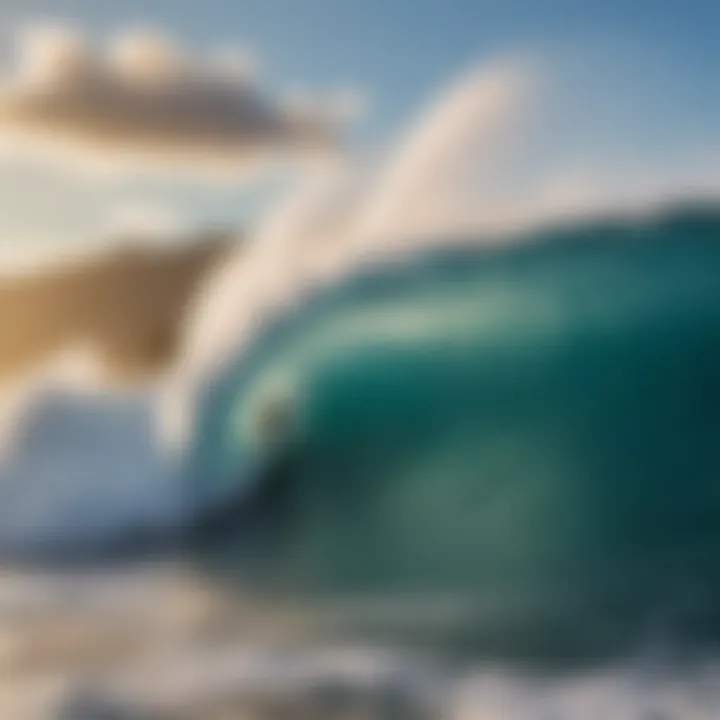
An interesting thing about this rule is it helps foster friendships within the community. When cyclists follow proper protocols, everyone has an enjoyable session. However, if someone cuts in front of another surfer without regard, it can lead to both tension and accidents.
Avoiding Conflicts on the Water
Staying out of the way of others is key. The ocean may be vast, but it's still important to know your surroundings. If you're not planning on taking the wave, ensure that you give space to those who are. Communicating with hand signals or shouting helps alert others of your intentions, avoiding unnecessary mishaps.
This approach not only cultivates good vibes but also encourages a safer surfing culture. A clear understanding of your surroundings and clear communication can defuse many situations that could brew into something more serious. The unique element here is the respect factor, and its absence can lead to difficulties—a crucial takeaway in maintaining a positive surfing environment.
Ocean Awareness
The ocean is both a beauty and a beast, and understanding it is essential for safety. Surfers must learn how to identify dangers lurking beneath the surface and assess conditions that change swiftly.
Identifying Dangers: Currents and Rip Tides
Currents and rip tides are a reality that every surfer should be familiar with. A rip tide can haul you out to sea in the blink of an eye, so recognizing them is vital. The classic sign is a break in the wave pattern or a noticeable current moving away from the shore.
Knowing how to identify and react to these conditions can save your life. While they're often mistaken as a simple strong current, they can cause severe trouble if ignored. The benefit here is being informed; understanding these dangers fosters an environment where surfers can continue to enjoy themselves while minimizing risks.
Assessing Wave Conditions
Every wave carries unique characteristics that affect its safety for surfing. Learning to read waves means knowing how large they can get, how frequently they break, and what the tide conditions are. A straightforward approach is to observe the water closely before paddling out. Are the waves peaking nicely, or do they seem chaotic and unpredictable?
This assessment is instrumental in determining whether conditions favor a safe experience or if it’s worth waiting for a different day. Comprehensive knowledge of wave conditions helps in making informed decisions and enhances the safety of every surfer out there.
Personal Safety Gear
Utilizing the right safety gear goes a long way to protect you from potential dangers while surfing. It’s not just about pushing your limits; it’s also about preparing for any scenario.
Wetsuits, Leashes, and Helmets
Each piece of equipment plays a distinctive role in ensuring a safe surfing experience. Wetsuits help keep you warm, especially in cooler waters, while leashes keep you connected to your board, reducing chances of injuring others. Helmets, though not as commonplace, provide an added layer of protection, especially during big wave days.
The combination of these items means that you’re less likely to find yourself in trouble, should an unexpected incident arise. While there’s a debate about whether helmets are necessary, they can indeed save lives, providing that extra ounce of security when it counts.
Emergency Protocols
Being prepared for emergencies should never be underestimated. Knowing whom to call and what actions to take in case of trouble can make all the difference. Establishing a game plan with your surfing buddies before hitting the waves creates a safety net. For instance:
- Make sure everyone knows how to perform basic first aid.
- Recognize the nearest lifeguard stations.
- Keep a mobile phone handy or a whistle for signaling emergencies.
The benefit of having these protocols in place is that they assure everyone involved feels safer knowing there's a plan for handling potential emergencies. When surfers feel safer, it supports a more enjoyable day on the water, enhancing the overall experience.
Proper safety considerations not only protect the individuals but foster community spirit, which makes surfing a joy rather than a chore. Embracing these ideas can lead to lifelong surf adventures.
Surfing Equipment Overview
Understanding the right equipment is essential for any surfer, whether you’re just starting out or you’ve been riding the waves for years. The surfing equipment not only influences your performance but also ensures your safety and comfort in the water. Different types of boards, apparel, and accessories contribute significantly to the overall experience. Choosing wisely can lead to smoother rides and a more enjoyable time on the surf.
Choosing Your Board
Types of Surfboards: Shortboards vs. Longboards
When it comes to choosing a surfboard, the debate between shortboards and longboards is a tale as old as the ocean itself. Shortboards are characterized by their length, typically less than six feet, making them highly maneuverable. They're favored by advanced surfers who seek speed and agility to perform tricks. Longboards, on the other hand, stretch over nine feet and offer a more stable ride. Many beginners find them easier to balance on, enabling learners to catch waves with greater ease.
Think of shortboards as sports cars, quick and agile but requiring skill to handle. Longboards, meanwhile, are like cruisers, steady and forgiving.
Each board has distinct advantages. Shortboards allow for quick turns and aerial maneuvers, while longboards shine in weaker, smaller waves, making them an ideal pick for surfers looking to enjoy a leisurely ride. However, shortboards can be challenging for newcomers due to their smaller surface area, which lessens stability.
Matching Board to Skill Level
Selecting the right board based on skill level is more than just a preference; it's crucial for safety and progress in surfing. A novice can easily become overwhelmed on a shortboard, which requires precise balance and technical prowess. Conversely, a longboard enhances the surfing experience for beginners by allowing them to focus on rhythm and elegance without the stress of falling frequently.
Key recommendations include:
- Beginners: Longboards provide a larger surface area for stability.
- Intermediate Surfers: Consider transitioning to a fish board or a funboard for a blend of speed and ease.
- Advanced Surfers: Shortboards can push you to master more complex maneuvers, but the short length requires careful navigation.
In summary, matching a board to your skill level not only improves your surfing abilities but also reduces the likelihood of accidents and frustration.
Apparel and Accessories
Functional Gear for Comfort and Performance
The right gear is vital for staying comfortable while surfing. The ocean is unpredictable; one moment you’re gliding smoothly over the waves, and the next you’re battling the elements. Therefore, functional gear is designed to protect you and enhance your performance. Wetsuits, for instance, provide insulation in cooler waters, letting you stay out longer without feeling the chill.
Key features of good surf apparel include:
- Breathability: Important for staying comfortable.
- Flexibility: Allowing ease of movement while paddling and riding.
- Durability: Resilient against waves and frequent wear.
When you’re well-equipped, you’re more likely to enjoy your time in the ocean rather than feeling restricted by your clothing or gear.
Layering for Changing Conditions
Surfing conditions can change rapidly, necessitating a flexible approach to apparel. Layering allows surfers to adapt to various weather scenarios. Starting with a rash guard forms the base, providing UV protection and preventing rashes while paddling. Then, adding a wetsuit can be helpful for the chillier parts of the day.
Why layering makes sense:
- Versatility: You can adjust as temperatures fluctuate.
- Comfort: Keeps you prepared without feeling stifled.
- Efficiency: Saves time and effort as you can easily switch tops or add/removal layers.
When done correctly, layering not only ensures comfort but also maximizes performance across different surf conditions. Be wise about your choices, and you'll surf smartly and safely, rain or shine.
Local Surf Schools and Lessons
Surf schools play a pivotal role in shaping the surfing journey for both novices and seasoned pros in Oahu. They serve as starting points for those eager to dive into the waters, providing guidance, safety, and a sense of community. Learning how to surf in the right environment is essential, as it not only equips surfers with the necessary skills but also fosters a deeper appreciation for the ocean and its rhythms.
Finding the Right Instructor
Accreditation and Experience
When searching for a surf instructor, one cannot dismiss the importance of accreditation and experience. Accredited instructors have typically undergone rigorous training programs, ensuring they are skilled not just in surfing but also in teaching techniques safely. A notable feature of accredited surf programs is their adherence to international safety standards. This means that as a learner, you can trust that you'll be offered personalized attention that's backed by proven methodology.
Choosing an instructor with experience can often be the deciding factor in how quickly and effectively a student can progress. Experienced instructors are familiar with local conditions and can tailor lessons accordingly. This individual approach can make a world of difference on the rocky path of mastering the waves. Insight from seasoned surfers like John John Florence could prove invaluable, helping students bypass common pitfalls and embrace the ocean's nuances more swiftly.
Customizing Lessons for Individual Needs
Customizing lessons for individual needs is an excellent way to ensure that learners of various backgrounds and skill levels find success on the surfboard. One significant characteristic of this approach is the focus on the student's goals—whether it's just catching a few small waves or aiming to compete at a higher level.
Instructors who take the time to understand personal objectives can design lessons that address unique strengths and weaknesses. For example, someone learning to balance might spend more time on flat water practice before hitting the waves, whereas a more confident learner could jump straight to the swells. The value here lies in the tailored experience, which often results in faster progress and greater enjoyment during the learning process.
Structured Learning Programs
Structured learning programs provide a backbone for surf education in Oahu. These programs range from beginner courses to advanced clinics, ensuring that surfers at all levels find their place.
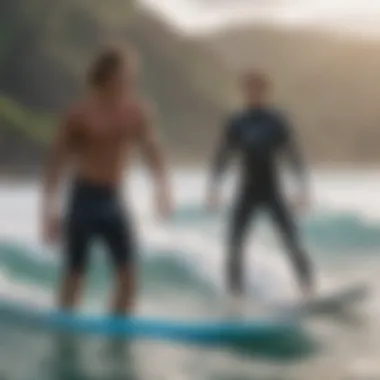
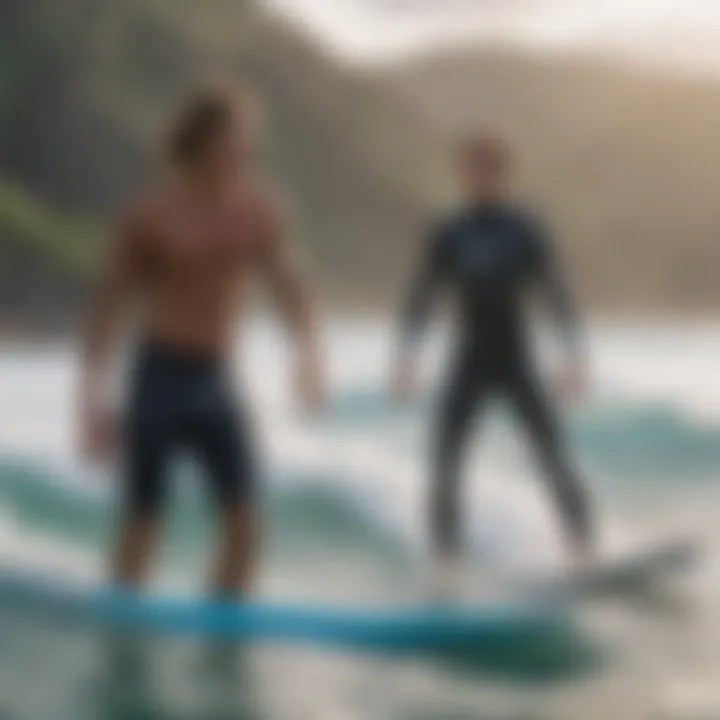
Beginner to Advanced Classes
The structure of beginner to advanced classes ensures that everyone has an opportunity to develop their skillset at a comfortable pace. This tiered approach is beneficial as it allows learners to progress systematically, building confidence as they advance through the levels. Each class focuses on specific aspects of surfing, ranging from basic paddling and positioning to advanced maneuvers and wave selection.
A unique feature of these classes is their community-oriented focus. Through shared learning experiences, surfers can forge friendships on and off the water. However, a potential downside might be that group classes sometimes lead to varying levels of attention for different students, but this is often mitigated by having experienced instructors who can manage diverse skill sets effectively.
Workshops and Specialty Clinics
Workshops and specialty clinics serve to hone in on specific skills within the surfing community. These programs offer targeted instruction, whether it's perfecting turns, improving wipeouts, or even understanding the ocean's currents better. A key characteristic here is the advanced focus; these clinics are not for novices and suit those looking to elevate their game.
What sets these workshops apart is often the presence of renowned surfers or coaches leading the sessions. Their insights draw surfers eager to learn from those who've made their mark in the sport. The unique angle of this approach is that it blends practical learning with inspiration, motivating participants to push their limits.
Local surf schools not only teach the art of riding waves but also instill a deep respect for the ocean's power and beauty.
The Surf Community in Oahu
Oahu's surf community is not just about waves and riders; it's a tight-knit network that embodies a way of life and a mosaic of cultural influences. This dynamic environment plays a vital role in nurturing new talent, promoting environmental stewardship, and preserving the island's rich surfing legacy. By engaging with local surfers, influencers, and various community events, newcomers and seasoned surfers alike can gain insights into not just how to ride the waves, but how to respect the ocean and its traditions.
Local Surfers and Influencers
Prominent Surf Icons
Prominent surf icons from Oahu have left an indelible mark on surfing worldwide. Surfers like Duke Kahanamoku and Buzzy Kerbox are household names who not only showcased extraordinary talent but also pushed the boundaries of what surfing could be. Their key characteristic lies in their ability to blend athleticism with an unwavering respect for Hawaiian culture. This is particularly beneficial for this article as it highlights how local heroes serve as role models for aspiring surfers, emphasizing the importance of tradition alongside innovation.
These surf icons boast a unique ability to inspire both local and global communities. Take, for instance, Duke's legacy of promoting surfing as an Olympic sport. Such initiatives have opened doors for many athletes who have followed, proving that the benefits of his influence extend far beyond Oahu's shores. This showcases the advantage of having icons who channel their skills into broader social impacts.
Grassroots Movements and Advocacy
Grassroots movements play a significant role in the Oahu surfing scene, focusing on environmental advocacy and community engagement. Initiatives like the Surfrider Foundation and local surf cleanup projects emphasize not only the need for clean beaches but also create a platform for community dialogue.
A key characteristic of these movements is their inclusivity. They invite everyone—from beginners to seasoned veterans�—to participate. This aspect is particularly beneficial for this article because it portrays the surfing community as accessible and welcoming, inviting all to contribute to a cause larger than themselves.
A unique feature of grassroots initiatives is their capacity to mobilize local support for environmental issues impacting all surfers, such as ocean pollution. The advantage of such activism ensures that not only current surfers but future generations will enjoy pristine waters and beautiful surf spots. However, challenges remain in garnering sufficient volunteer participation, often limited by the very surf culture that pulls many into the ocean.
Community Events and Gatherings
Surf Competitions and Festivals
Surf competitions and festivals in Oahu harness the spirit of camaraderie and showcase local talent. Events like the Vans Triple Crown of Surfing gather surfers from across the globe, but at their heart, they celebrate community spirit. This key characteristic attracts fans and participants who share a love for waves and the ocean, cultivating an environment full of excitement and mutual respect.
The unique feature of these events is their dual nature: they serve as competitive platforms while also fostering connections between surfers. While a competitive edge exists, larger gatherings often prioritize shared experiences over mere rankings. This emphasizes why such events are a popular choice for inclusion in this article; they encapsulate what the surf community stands for—collaboration, celebration, and respect for nature.
The downside, however, is that they can sometimes prioritize top-tier surfers, overshadowing emerging talent. Striking a balance to accommodate both is crucial for the community's growth.
Environmental Initiatives
Local community events often incorporate environmental initiatives, reflecting Oahu's commitment to preserving its beautiful landscape. Beach cleanups, reef restoration projects, and educational workshops abound. A key characteristic of these initiatives is their proactive approach to environmental challenges generated by surfing and tourism.
Incorporating such initiatives in the article is significant; they highlight the surf community's responsibility toward sustainability. The unique feature lies in their ability to disperse knowledge and create awareness, serving not only current surfers but educating new generations and tourists about the fragile nature of their paradise.
However, these efforts often face hurdles like limited funding and volunteer engagement, which can hinder their effectiveness. But the vision to create a more responsible surfing culture keeps pushing forward, reminding all water enthusiasts that they have a part to play.
"The ocean's beauty is not just in the waves; it lies in how we choose to protect it for generations to come."
In sum, Oahu's surf community stands as a microcosm of cultural richness, where local surfers and grassroots advocates work hand in hand to create an atmosphere that not only cherishes the sport of surfing but fosters a deeper connection with the ocean. Surfers of all backgrounds can find a place here, learning how to engage with their surroundings, celebrate their skills, and advocate for the ocean they love.
Exploring Oahu Beyond Surfing
Oahu is famous for its surf culture, drawing enthusiasts from around the globe who seek the thrill of riding its waves. However, there's so much more to this island than just surfing. Exploring other activities can enrich the experience and provide deeper insights into the island's beauty and traditions. For surfers, understanding these additional pursuits can enhance their overall trip, offering a well-rounded perspective that goes beyond just the beach.
Other Water Sports
Kiteboarding and Stand-Up Paddleboarding
Kiteboarding and stand-up paddleboarding, or SUP, have become increasingly popular on Oahu's waters. For those who thrive on adrenaline yet seek a different challenge, kiteboarding offers a unique blend of sailing and surfing. Riders harness the wind with a large kite, gliding across the water's surface, leaping into the air for exhilarating tricks.
Conversely, stand-up paddleboarding allows for a more relaxed approach. The sport's low barriers to entry make it accessible for all ages. Paddleboarding offers a chance to explore Oahu's calm bays and estuaries, where you can often spot colorful fish and other marine life.
Both sports provide physical workouts while allowing individuals to enjoy the stunning scenery from a different vantage point. Kiteboarding is thrilling but requires specific conditions and equipment, while SUP is more approachable and can be done almost anywhere.
Diving and Snorkeling Opportunities
For those who wish to dive deeper—literally—snorkeling and diving in Oahu unveil the vibrant underwater world teeming with life. Locations like Hanauma Bay are renowned for their crystal-clear waters and biodiversity, allowing snorkelers to get up close with coral reefs and tropical fish.
On the other hand, scuba diving opens up an entirely different realm. The rich marine environments, submerged wrecks, and underwater caves offer adventures that can be both exhilarating and calming. Diving in these waters can transport you to hidden worlds and let you experience the tranquility of the ocean.
Each activity enhances the appeal of the island, though they do require some preparation, particularly regarding safety gear and the right conditions. Both snorkeling and diving can cater to various experience levels, making them attractive options for aquatic adventurers.
Cultural Experiences
Traditional Hawaiian Practices
Engaging in traditional Hawaiian practices allows visitors to appreciate the island's heritage. From hula dancing to lei-making, these practices connect one not only to the island's history but also to its community values. Participating in these activities provides insight into the cultural principles of Aloha and Ohana, fostering respect for both nature and shared experiences.
These traditions are not merely performances; they symbolize the embodying spirit of Hawaii. Learning hula, for example, tells stories that give life to the land and sea—stories that are thousands of years old. It’s a chance to immerse oneself in the authentic essence of Hawaii, enriching any visit to the island.
Exploring Local Cuisine and Art
Cuisine and art serve as critical windows into any culture, and Oahu is no exception. Exploring the local food scene leads you through influence from various cultures, yielding a rich tapestry of flavors. From poke to loco moco, trying these dishes represents a journey of its own. Food trucks and local markets, like those at KCC, offer a palette of tastes that reflect the island's diversity.
Art, too, plays an important role in telling Hawaii's story. Visiting local galleries and markets can reveal the work of native artists who draw inspiration from their surroundings. Participating in workshops or gallery tours allows visitors to engage directly with the creative spirit of the island.
Engaging with these cultural experiences is not a mere diversion; it enhances understanding of the land and its people, creating a lasting bond between the visitor and the island.
Adventurers, surfers, and culture enthusiasts alike can benefit tremendously from exploring Oahu beyond the surf. Each layer unveils a deeper connection to the island, elevating the surfing experience while also creating treasured memories that resonate long after the waves have calmed.
End
The journey into Oahu's surfing culture reveals its profound importance, resonating with both locals and visitors alike. Surfing here is not merely a sport but part of a lifestyle, interwoven with the island's heritage and its communities. This article has aimed to provide insights into surfing's deep-rooted significance in Hawaiian society, embracing its historical context while considering modern influences and environmental aspects that shape the surfing experience.
Reflections on Oahu's Surfing Heritage
The Ongoing Evolution of Surfing
The ongoing evolution of surfing in Oahu is a topic that carries both layers of complexity and richness. Surfing has transformed significantly over the years, influenced by innovations in technology and shifts in societal attitudes. Modern surfers have access to cutting-edge gear that can enhance their experience. For instance, the introduction of epoxy surfboards has changed the game, offering durability and performance.
Moreover, surfers of today often blend traditional methods with current practices, maintaining a connection to their roots while also pushing boundaries. This duality is a key characteristic of the evolution we witness in surfing. The rise in surf tourism has made the sport more accessible, yet it also raises concerns about overcrowding at local spots. It’s essential to strike a balance between welcoming newcomers and preserving the sanctity of cherished surf breaks.
"Surfing in Hawaii is more than just a ride on a wave; it's a story in itself that continues to unfold."
Encouraging Respect for Nature and Culture
The significance of encouraging respect for nature and culture cannot be overstated in the context of surfing in Oahu. A fundamental aspect of the surfing lifestyle is an intrinsic respect for the ocean and its environments. Surfers learn to read the waves and currents, understanding that their connection to the water is a two-way street. Awareness of environmental factors, like coral reef conservation, has become vital.
Promoting respect also entails valuing the cultural heritage of Hawaii. Local traditions, teachings, and the sacredness associated with surf spots form an essential foundation of this community. Educating surfers—especially tourists—on etiquette and cultural appreciation fosters a sense of responsibility. The unique feature here is the delicate balance surfers must maintain between their passion and the ecological impact of their sport. Understanding this can augment respect and awareness, creating a more sustainable surfing environment.
In wrapping up, the conclusion of our exploration into Oahu's surfing scene serves as a call to action. The ongoing evolution of this sport, paired with a commitment to preserving the natural and cultural landscape, enhances the surfing experience for everyone involved. The knowledge gained from these reflections not only enriches individual surfers but contributes to a larger narrative of respect and sustainability.















